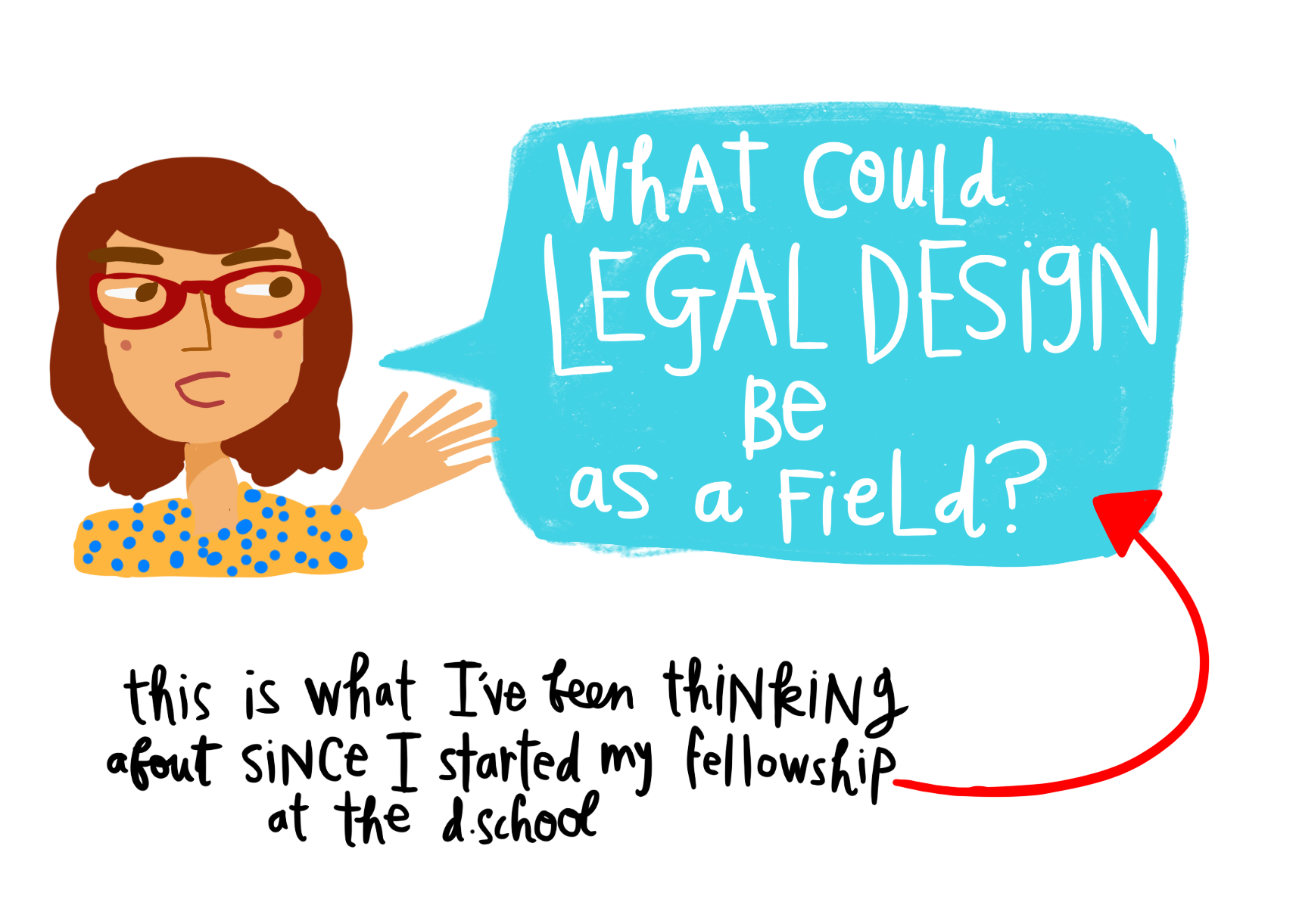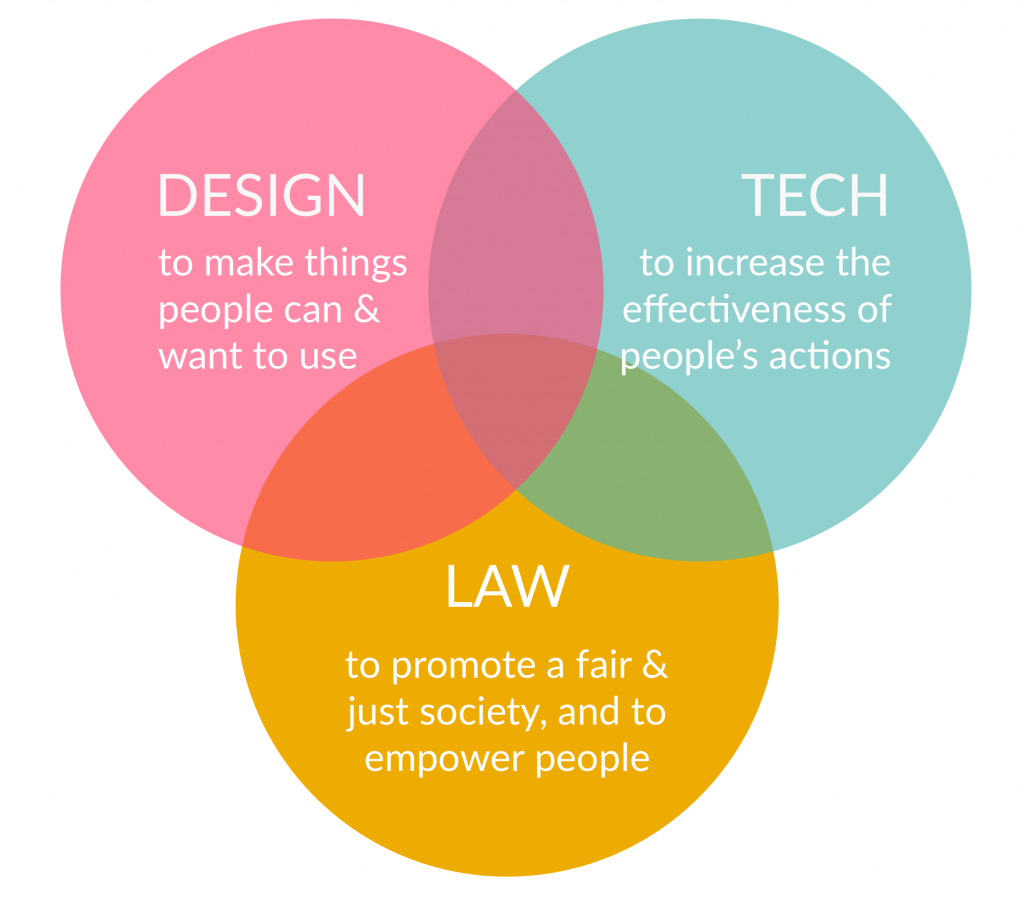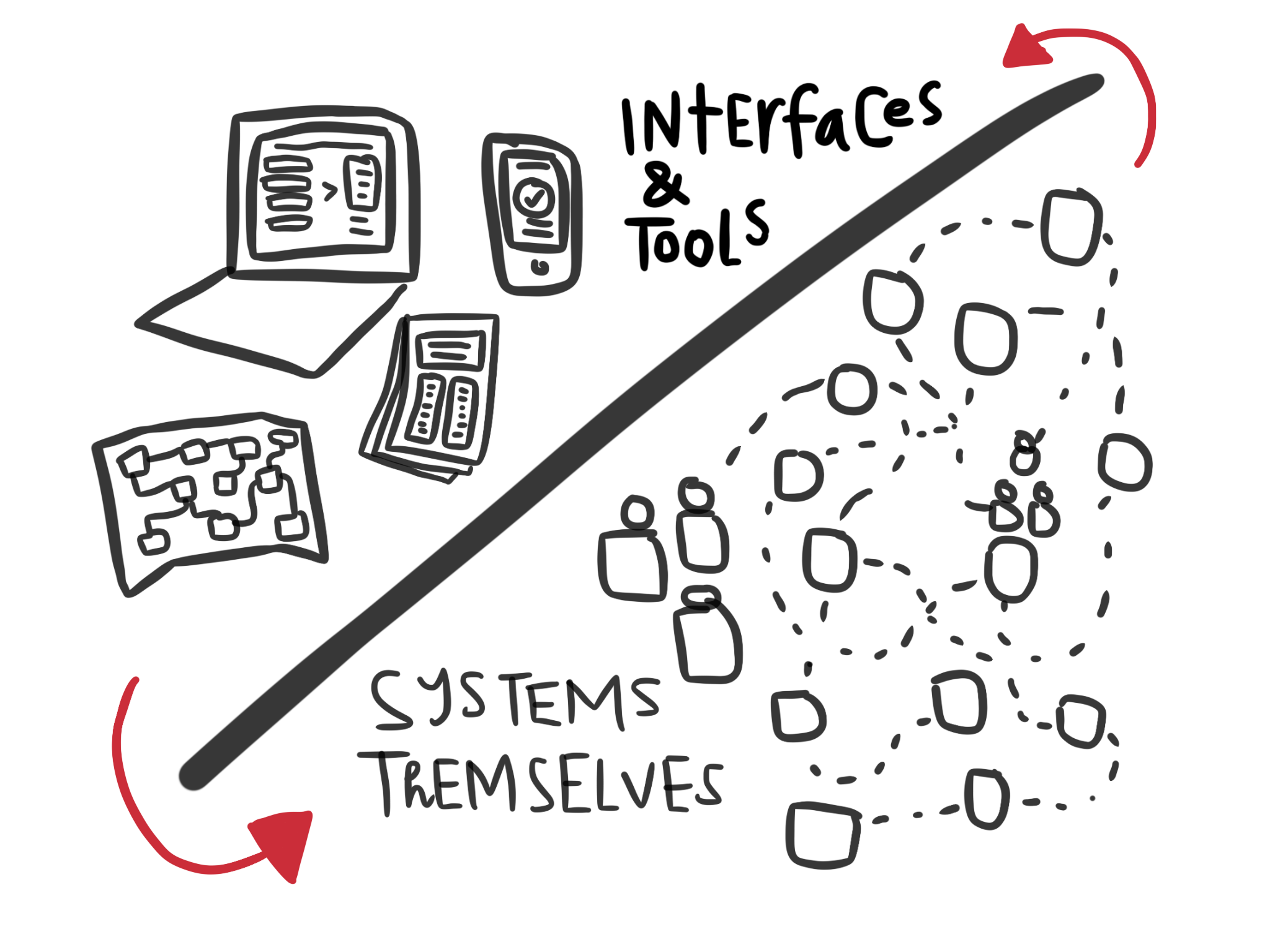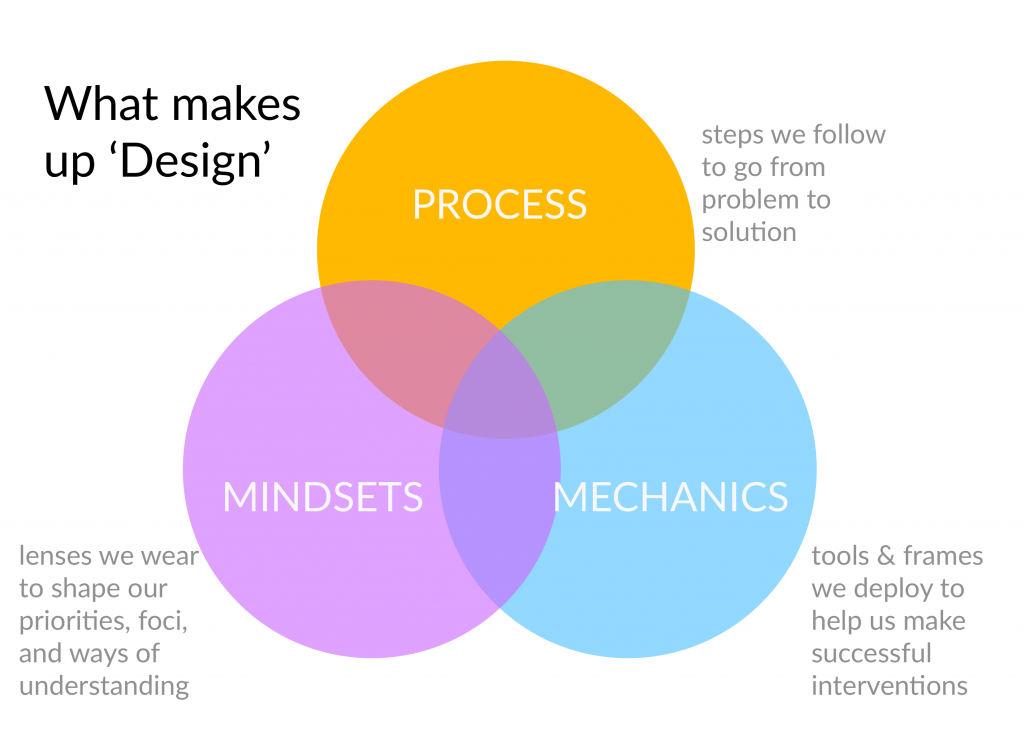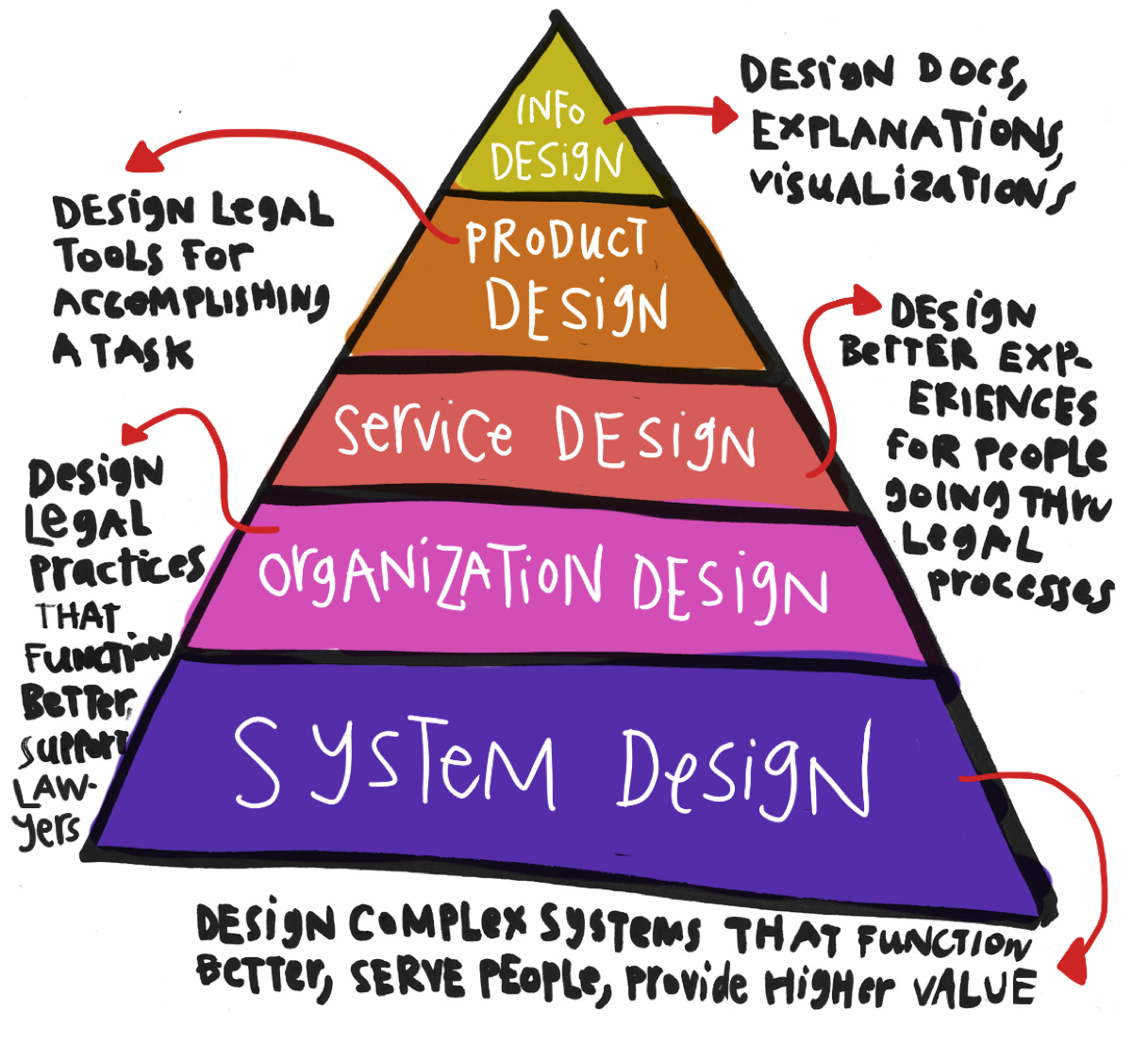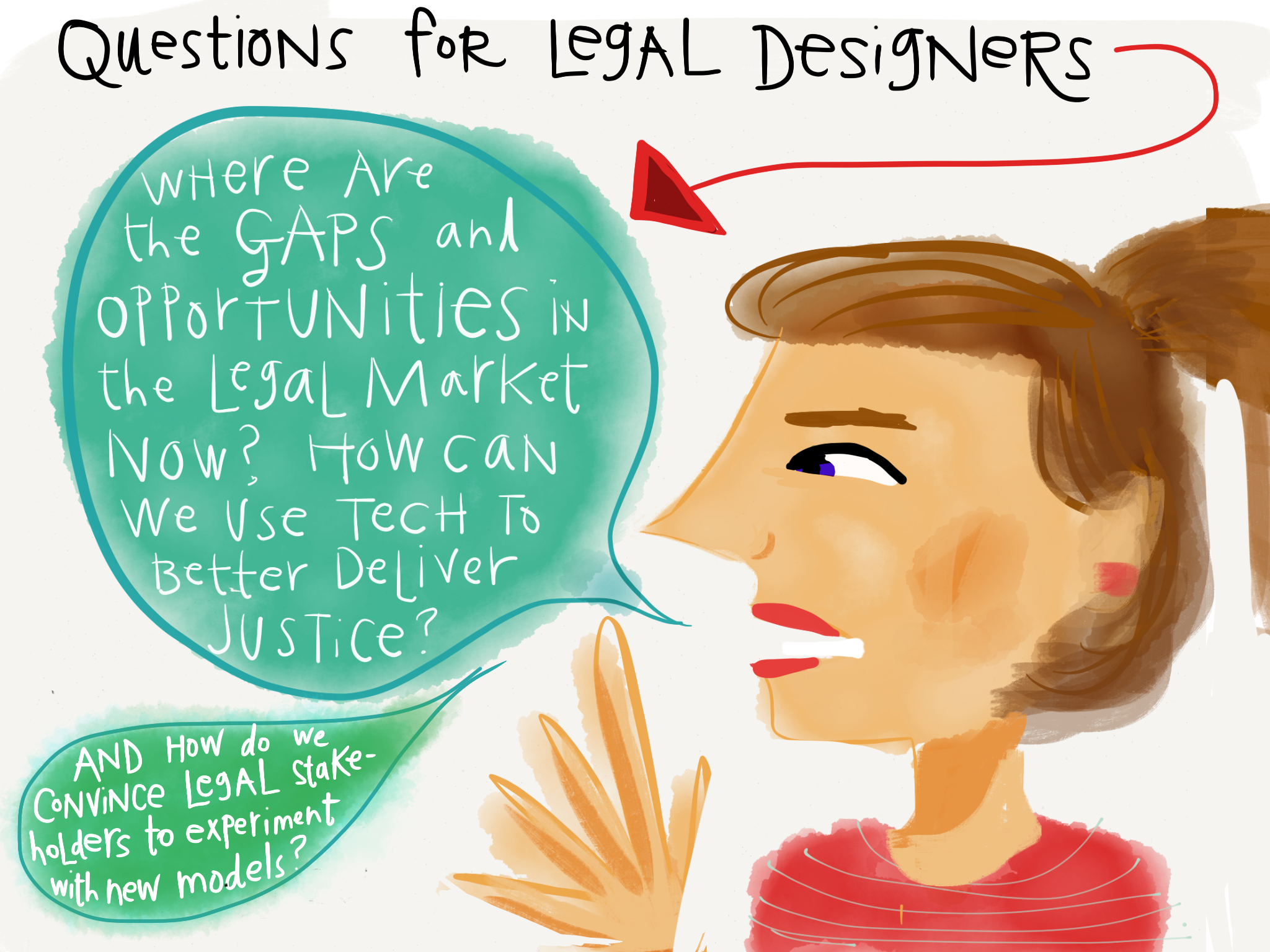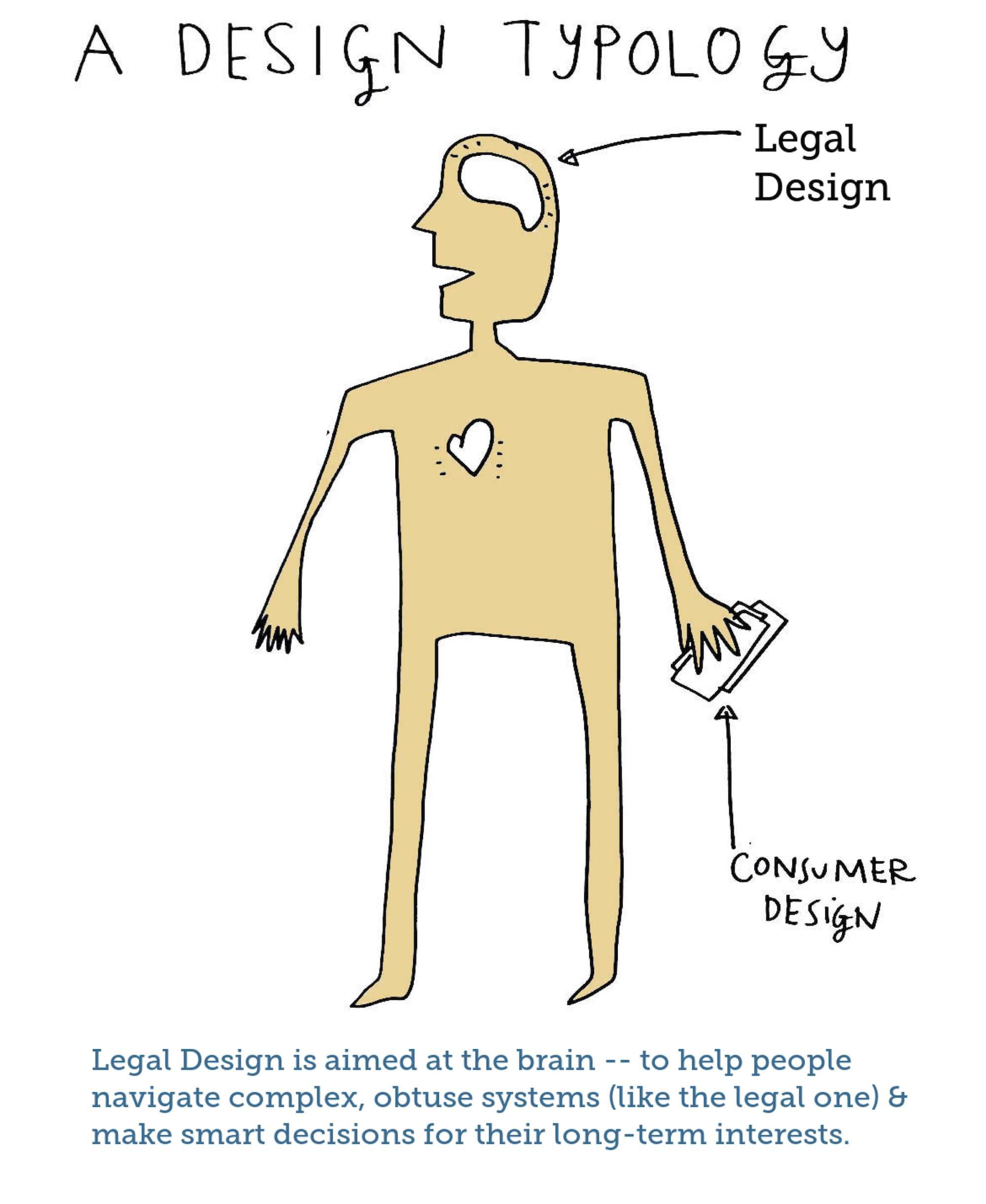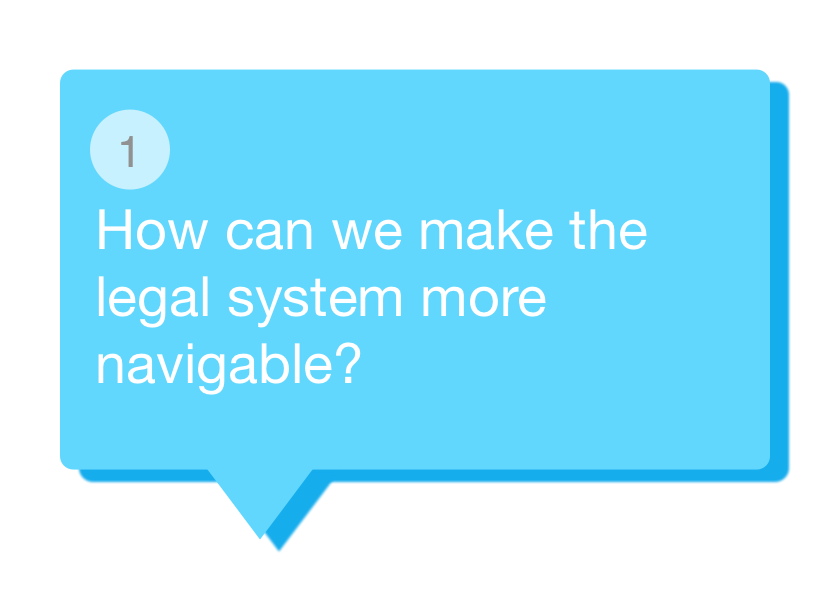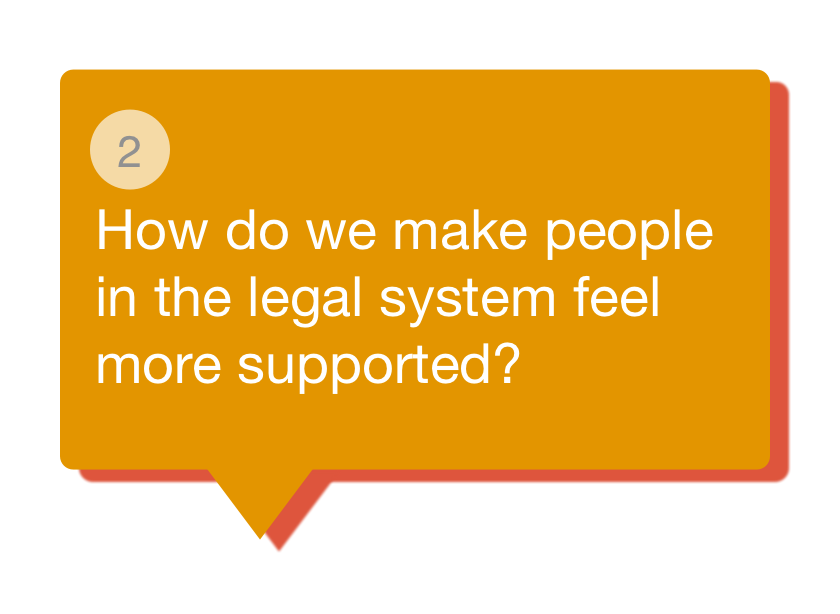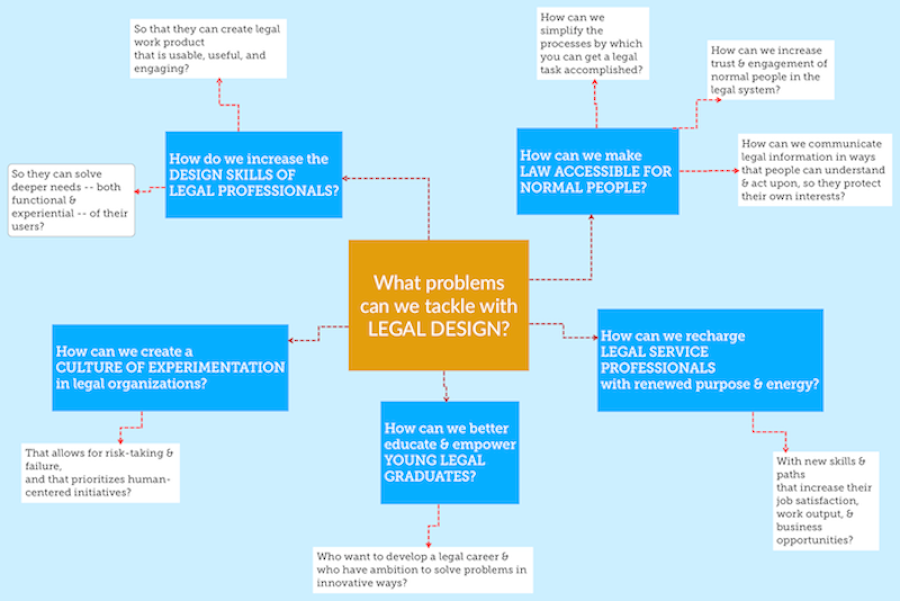In this introductory chapter, I introduce the concept of ‘Legal Design’ & define what Design and Design Thinking mean.
What is Legal Design?
Legal design is the application of human-centered design to the world of law, to make legal systems and services more human-centered, usable, and satisfying.
Legal design is a way of assessing and creating legal services, with a focus on how usable, useful, and engaging these services are. It is an approach with three main sets of resources — process, mindsets, and mechanics — for legal professionals to use. These three resources can help us conceive, build, and test better ways of doing things in law, that will engage and empower both lay people and legal professionals.
It brings a culture of design thinking, user research, and human-centered design methods into the world of law. And in the process, it sets key new metrics for how we operate in the world of law. Are we delivering services that are (1) usable, (2) useful, and (3) engaging.
Design offers methods and priorities to transform the legal sector, to make legal outcomes more aligned with those its users desire, and to create ambitious new visions for how legal services can be provided. A design approach to legal services puts people and their contexts as the focus, questions how their status quo could be improved, and then considers the potential of technology as an intervention.
Its first principle is that Lawyers & Designers should be working together to create truly user-friendly, engaging, quality legal services. Designers can help lawyers. Lawyers need designers’ skills and insights.
The Goals of Legal Design
Legal design has three orders of goals.
- Helping the lay person and the legal professional;
- Creating a better front-end to the legal system and a better back-end;
- Working for incremental short-term improvements and breakthrough long-term change.
Related to these are two main stakeholders, separate yet interlinked: the lay person, and the legal professional. For the lay person in the legal system: how can we make her smarter, more empowered, and in control of the complexities of their legal matters and the laws that apply to them? For the legal professional: how can we support her to practice law better, to serve her clients in richer and more efficient ways,
Legal design asks how we can increase wisdom, empowerment, and strategic decision-making. Its aim is to improve people’s comprehension of the rules & systems that apply to them — and give them the power to navigate the legal system in the most strategic and intelligent way.
Legal design focuses on both the front-end of the legal system & its back-end. For the front-end, legal design uses the power of design mindsets & process to create better interfaces and tools with which people can navigate the legal system. For the back-end, it uses these same means to create more intuitive systems and rules. Half the battle (perhaps the first half) is putting layers on top of the legal system to make it easier to understand and deal with. The other half is improving the design of the actual legal system.
Legal design can also work on two different levels of magnitude: the incremental and the breakthrough. Taken modularly, legal design can be used as another tool for a legal professional to have in their problem-solving repertoire. Or it can be used in whole as a process for innovation & implementation, to develop new ideas into new products and services, that can be rolled out agilely from pilot to scale. Both breakthrough and incremental changes are needed in the world of law, to get changes happening in the short term while also laying the groundwork for long-term seismic improvements.
What Legal Design Can Offer
Beneath these high-order of goals, legal design sets out some more concrete targets for projects to tackle. Legal design can improve from the status quo by offering:
- Improved Problem Solving: To be more forward-thinking and creative in generating solutions for problems
- Client-centered Services: To put the focus on the client, and win clients in better ways, deliver them better services tailored to their explicit (and buried) needs — and to communicate information to them in clearer, more compelling, and more usable ways.
- Better Communication: To communicate information — particularly complex legal information — in a clearer, more compelling, and more usable way.
- Richer Legal Profession: To build a new set of professional paths and opportunities for lawyers, with new kinds of jobs and competencies.
- Better Legal Organizations & Worklife: To develop new ways of collaborating, improving processes and decision-making, and build stronger communities inside of legal workplaces
- New Products & Services: To generate ideas of how to serve clients, lawyers, and the general public in new ways — through technology or otherwise, and to build ideas into viable products and businesses.
What is design? A definition for lawyers
With all this talk of the promise of design, it’s worth taking a step back. When we talk about design, what are we talking about?
Lawyers’ main misconception about design is that it is about making something look prettier, sharper, better. Most people reduce design to aesthetics, like font choice, color, or PowerPoint slide templates. It’s about superficial appearance, how something looks. Appearance is certainly a major factor in the design of a thing, but it is not all of what design has to offer — and it is certainly not the heart of what design is.
Design is about making things that are intuitive, engaging, valuable, and beloved to the people that use them.
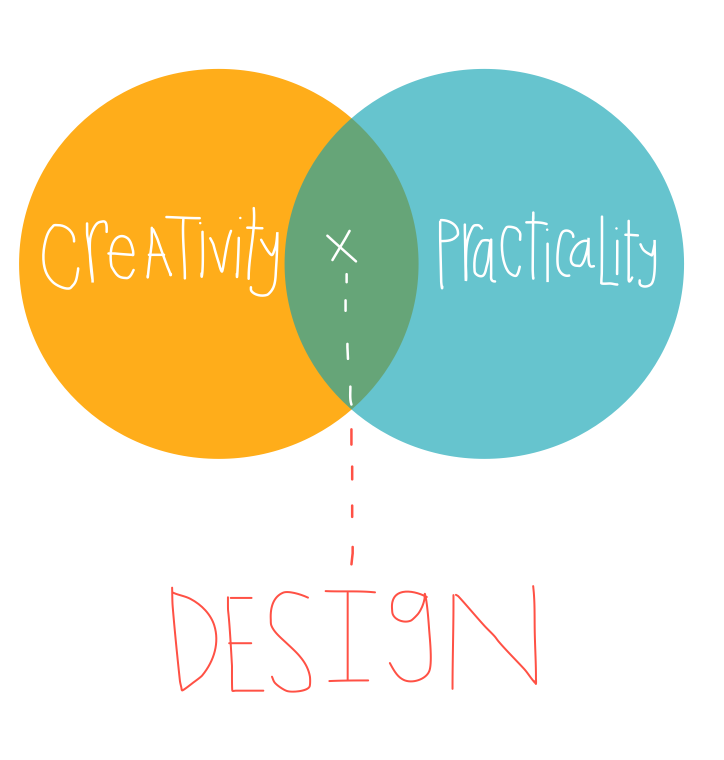
More expansively, design is an approach to problem-solving. It is a process that we can use to spark innovations. Design — particularly ‘human-centered design’ — focuses on spotting its target audiences’ deep-seated and compelling needs, in order to craft interventions that will improve these people’s experience and deliver them value. It focuses on ‘user experience’, and how to compose visuals, products, services, and systems that will deliver this excellently. It centers on the end users of the problem area, and embraces an experimental, action-oriented, iterative approach to generating several possible solutions for a problem, testing them, and then scaling up the successful ones to larger implementations.
Just like you can ‘think like a lawyer’, you can ‘think like a designer’.
 Design offer a structured yet flexible path to coming up with great ideas and implementing them. Rather than scouting in the dark or flailing wildly about how to solve problems in your organization, or how to improve the services you provide to your users, design gives you a clear process to follow (and to adjust). It offers you mindsets that will help you see the challenge area with greater insight, and get to promising ideas and prototypes with more efficiency and chance of success.
Design offer a structured yet flexible path to coming up with great ideas and implementing them. Rather than scouting in the dark or flailing wildly about how to solve problems in your organization, or how to improve the services you provide to your users, design gives you a clear process to follow (and to adjust). It offers you mindsets that will help you see the challenge area with greater insight, and get to promising ideas and prototypes with more efficiency and chance of success.
Being that design is a set of methods and mindsets, it can be implemented in various ways – not always for the same purpose. A design process can be applied in a quick and lightweight way as a problem-solving tool, to find ways to resolve a complicated situation or to create a new intervention that will address a need. It can be used in a development cycle, to create a better work product – be it a new communication, new product, new service, or new system. Design can be a generative process that leads to the launch of a new thing. And finally, design can be used as a research method, to generate data and insights about a particular topic.
Design’s core values
Design is about usability, it is about utility, and it is about engagement. It is about looking at all the things and systems in our lives and considering — how could these be better? How could they be easier to use? How could they offer us more value? And how could they engage our attention and commitment in better ways? Design is about user-centeredness: paying attention to how people use things and deal with systems, and using creative, collaborative methods to improve a person’s experiences.
Design is a discipline centered around HOW. How to make things — communications, products, services, systems — in a way that will mean they are successful in solving human problems, addressing human needs. At its core, design is the practice of making things that are usable, useful, and engaging.
Design as process, mindsets and mechanics
It can be useful to think of design as a collection of process, mindsets, and mechanics. Taken together, they offer a way to solve problems and create ideas. The chapters of this book is structured around these three categories — with deep dives into the design process you can use to structure your actions, the mindsets to use to focus on the right things, and the mechanics to help inspire your ideas and ensure your designs are engaging and relevant.
Types of design
Design is about solving problems. It has many different branches defined by which type of challenge the designer trying to solve.
Visual design, but people most commonly mistake all of ‘Design’ for –it is focused on how information is presented to its audience, and how to engage inform and communicate the message to the audience Visual graphic tools. It is the branch of design that is concerned with how things look, but its concern derives not mainly from aesthetic value, but instead on functionality in delivering a message effectively to people.
Visual design will help you produce more and usable work product. It will improve your communication skills. Especially if you create documents or presentations, Visual design give you the essential mindset and instincts, as well as specific tools to implement better communications.
Other branches of design are product design–about how designers can develop tools and things that can help accomplish help her user accomplish tasks in better ways. Product design focuses on how to construct a tool to solve a user’s problem. What is a thing you can build to help a person accomplish a task, resolve a challenge? Product design is commonly seen in the start-up world — trying to build a great app, a great website, a great machine or thing, that will solve a need, fill a void, get users to buy and use it.
Service design rises to a more complex scale of solutions. It is concerned with a user’s journey from problem situation to resolution, and how the user’s experience can be improved along this pathway. Service design involves the other orders of design — products, visuals, communication, organization — bringing them together to construct a series of experiences for its target user. It is like the staging of a play or a movie — trying to attract an audience, keep their attention and good will, and bring them through a series of scenes and interactions to a final resolution.
Organization design focuses on how people can work together and accomplish better outcomes in sync. It can involve changing staffing, space, compensation, incentives, and culture in an organization. Much of the challenge lies in how many stakeholders are involved in org design, and how many target users the designers must serve.
System design is the most complex type of design, which attempts to coordinate a large scale of products, services, communications, and interactions together into a large and ongoing system of people. Some examples of system design are creating a new court, a new agency, or university program.
Design Thinking means bringing design into other domains
Design doesn’t live only as the province of professional designers who have studied it for years. Anyone has the capacity to become a designer. The process is learnable, and it is also learnable in stages and modules, as is useful to certain parts of their own practice. A graphic designer, a fashion designer, or an industrial designer has an enormous amount of skills and instincts to create wonderful, high-resolution finished designs.
But it is also easy to be an amateur designer — making use of the process, mindsets, and mechanics it has to offer. Even if you cannot make a gorgeous visual or a saleable product, you can create concepts and specifications to hand off to professional designers for them to implement. And as you practice acting and thinking like a designer, you can build your capacity to produce high-resolution work product yourself. Design is a muscle you can build through practice.
Design as applied to other fields — like law, education, the government, management, health-care and beyond — has come to be termed ‘design thinking’ It’s a way of using a professional designer’s process, mindsets and mechanics, but to adapt them for use by non-designers in their own domain.. Design thinking is a mindset, with its own set of methodologies, frames, and priorities. Design thinking helps professionals tap into their own expertise while structuring them through what ‘innovation’ could actually be. Innovation is not a magic process. It is something that professionals can be trained in, and design thinking offers guidance to do so.
Design is a field of ‘how’s that can make a world of ‘what’s (like law) better.
Design thinking is not just for people who are working on legal tech startups, branding, or visual communication. It is for any person in the legal sector who wants to serve their clients better, who wants to improve their own work life and organization, and who wants to see better kinds of work product, service delivery, and ecosystems in law.
Legal Design vs. Design Design
In contrast to many other kinds of design, legal design is focused not so much on persuading users to consume a product or an experience, or on feeling a particular emotion. Rather, it is about increasing a person’s capacity to make strategic decisions for herself. Its target is more the brain, and less the heart or the wallet. Legal design aims to build environments, interfaces and tools that support people’s smartness — and to shift the balance between the individual and the bureaucracy.
That is not to say that consumerism, emotional connections, and commercial methods can’t be useful parts of legal design work. We should still be tuned into our users’ emotional states and preferences for spending money. But the driving concern should be enhancing their wisdom and comprehension.
In its unique focus, legal design has its own set of guiding principles and patterns. What makes for a good product? How do we communicate effectively? What kind of service experiences will suit our users? The answers in the legal sector can be narrower than those in general design processes. That is where Legal Design Mechanics — explored at length in Chapter 4 — sets it apart.
Key Challenges for Legal Design to Tackle
What kind of projects can legal design work tackle? In my initial design research & work, I have played around with many “How Might We…” questions. When it comes to making a more user-centered legal system, five key challenges have emerged as prime ones for legal design to be focusing on.
I’ve also mapped out other challenges that focus on improving the work, effectiveness, and culture of legal professionals. These legal design challenges go more into detail about the changes that need to be happening to promote innovation and create new kinds of legal services and organizations.
New Training & Leadership: How do you train a new generation of legal services leaders? How do we bridge generational gap inside of the legal profession? How do we address the generational gap inside legal aid organizations? How do we prepare a new generation of leaders for legal orgs — who know technology and how to lead in smart appropriate strategic ways, especially after current leadership retires? These are all challenges that legal design could address.
New Legal Cultures: How do we create a culture of innovation inside legal service organizations? How do we experiment with new types of pilots & strategies? Creating spaces for experimentation is crucial for driving change in the world of legal services — and giving some autonomy and runway for designers, technologists, and innovators who want to try new ways of doing things.
Improved Communication: How do we communicate legal process to use better to our clients? How can we educate people about the law in a better way — so that legal information is more engaging, comprehensible, and actionable?
Increased Engagement: How can I get people to follow through on a legal process? How can we incentivize more people to take care of their legal health, and feel a greater sense of procedural justice when they do encounter the legal system?
Better User Experience: How do we treat as users in a better way? How do we help people understand what the right path is for them? How do we make happier clients? How do we make our work product more usable?
Smarter Technology: How do we use the Internet as a legal resource? How do we get people who are searching on the internet to the right legal path? How do we leverage technology in smart ways to improve legal services delivery, through data, smart assistance, and interactive customization?
And here is one more map, with even more challenges to tackle, particularly for designers and technologists to be working on together:
How do we start to tackle these many challenges? Design mindsets, process, and mechanics offer structured ways for us to understand what could be changed about our current legal system & create new innovations for it. In Chapter 2, the core mindsets of designers are laid out, to help us take a more creative, open-minded, collaborative approach to solving problems. In Chapter 3, the process is laid out in detail — what steps to be taking, what stages of activity to engage in, what tools to be using. And Chapter 4 presents mechanics — shortcuts, frames, insights, and other things that have already been established by other designers and researchers working on these challenges — that can supercharge your own work.
